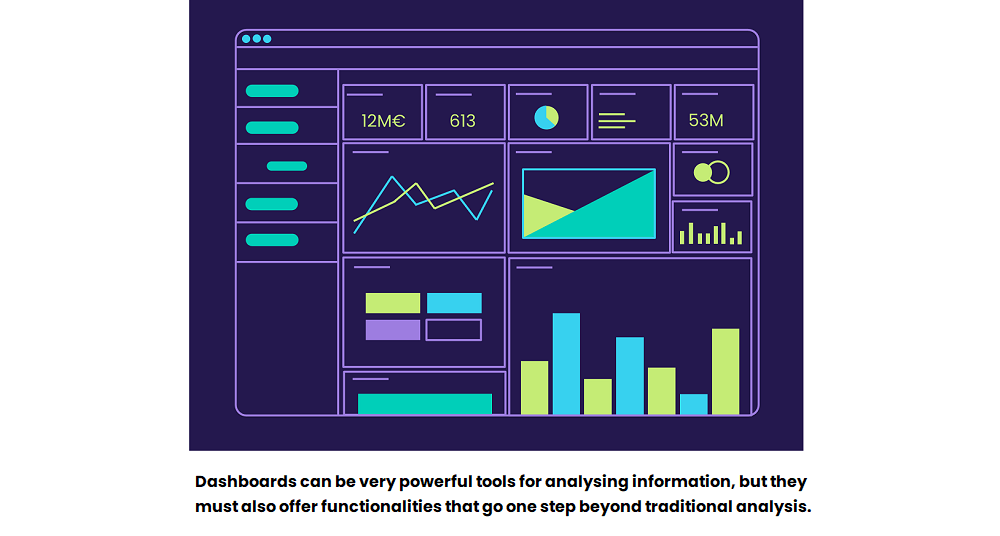


02/11/2023
In the age of information and data, dashboards have become key tools in informed decision-making processes. Understanding the different types of dashboard and knowing how to select the most suitable one can make the difference.
In this article, we are going provide an excellent guide, where we reveal the secrets to selecting the perfect dashboard for your needs.
What is a Dashboard?
Before delving into how to select the suitable dashboard, it is important to understand what a dashboard exactly is.
Dashboards are a key tool in the decision-making process, as they analyse and show essential data and metrics in a visual way so we can monitor them. When gathering data from different sources and presenting them in a clear and concise way, dashboards can help users to understand trends, identify problems and take measures to improve performance.
There are three main types of dashboards: descriptive, predictive and prescriptive. Each has its own strengths and weaknesses, and the most suitable type for a particular user will depend on their specific needs.
Descriptive dashboards
In a world driven by data, the capacity to swiftly and effectively access valuable information is a critical skill. Here is where descriptive dashboards remain victorious. They are like a map guiding you through a labyrinth of data, providing a clear and accessible overview without requiring advanced technical knowledge.
What are Descriptive Dashboards?
As their name suggests, they are designed to describe, summarise and visualise data. Their main function is to present information in a clear and direct manner, without delving into complex analyses or predictions.
Descriptive dashboards are a good option for users that need a fast and simple overview of data. They are easy to understand and use, even for users that do not have an advanced technical knowledge. However, they can sometimes be very dense due to the amount of information represented.
Prescriptive dashboards
Another type of dashboard, more advanced, is the predictive dashboard. They not only provide an overview of data, but they also reveal hidden trends and patterns.
What are Predictive Dashboards?
Predictive dashboards are an evolution of descriptive dashboards. They do not just describe, they also explore and analyse. These panels incorporate advanced techniques, such as grouping, correlation and regression, to anticipate future actions. In essence, they are the compass that guide you beyond past data towards what the future holds.
Predictive dashboards have a superpower: the capacity to reveal what is not evident at first sight. In the world of data, there are often hidden patterns and opportunities that we cannot identify at first sight. Predictive panels employ multiple advanced techniques to identify these hidden treasures. They can help you to detect problems before they become a crisis and recognise opportunities before you miss them.

Prescriptive dashboards
In the world of data, moving forward with confidence is any leader’s aim. Prescriptive dashboards are the apex of this evolution, opening a window to a world of possibilities that go beyond mere prediction. These panels not only describe or predict, but they also prescribe actions based on accurate data.
What are Prescriptive Dashboards?
As previously mentioned, prescriptive dashboards are the apex of data-based decision-making processes. Beyond description and prediction, these panels are able to provide specific recommendations for the future. They achieve this by employing machine learning technology and advanced analyses of data to identify patterns and trends.
If predictive dashboards are a window to the future, prescriptive dashboards are the key to opening that door. They are ideal for those who seek to anticipate problems and make the most of opportunities before they arise. Whether you are a CEO that wants to make strategic decisions based on data with confidence or a manager that needs to improve your team’s performance, prescriptive dashboards will guide you.

Prescriptive, Analytics, optimisation, examples, data, mining, trends, inputs, media, chats, maturity, audio-video, actions, retain, customers, statistical, subscribers, unstructured, correlations, methods, answered, offers, personalised, rushing, demand, industry, edge, predicting, different, companies, dashboards
Tips and advice to design your dashboards
After learning about all the available dashboards, we are going to focus on how to make the most of them.
In the world of designing dashboards, the key to success lies in understanding your users in depth. At CaixaBank Tech we understand the importance of this premise. We are committed to creating tools that are intuitive, efficient and that flawlessly deliver relevant information.
Below are a few tips to design dashboards with an impact.
Select the Correct Type of Dashboard
The first step is to select the type of dashboard that best suits your needs. Do you need a general description, an analysis or predictions? The type of dashboard you select must be aligned with your and your users’ objectives.
Define Clear Objectives
Having a clear vision of what you want to achieve with the dashboard is crucial. What actions should users be able to perform? Establishing specific objectives will guide you in creating a truly effective tool.
Consider Your Users' Needs
Putting yourself in your users’ shoes is essential. What type of information do they need? How do they prefer it to be presented? Having empathy with users is the key to designing a dashboard that meets their needs.
Clear Visual Communication
Charts and tables in your dashboard must be like clear windows. They must communicate information in a clear and concise way. Simplicity in the design is crucial for an effective understanding.
User Personalisation
Each user is unique, and their needs can vary. Offering the possibility of personalising the dashboard enables each individual to adapt the tool to their specific requirements.
Select the dashboard perfect for you
The type of dashboard suitable for you will depend on your specific needs. If you need a quick and simple overview of the data, a descriptive dashboard is a good option; however, if you need a better understanding of the data, you should consider a predictive dashboard. In the event of having to make proactive decisions, you must go one step further and add prescriptive functionalities.
Here are some examples of situations in which you can use different types of dashboards:
- A sales manager can use a descriptive dashboard to view the return on sales per product, region or channel.
- A marketing manager can use a predictive dashboard to identify trends in the customers’ behaviour.
- An operations manager can use a prescriptive dashboard to identify opportunities for improvement in the production process.
tags:
share:






